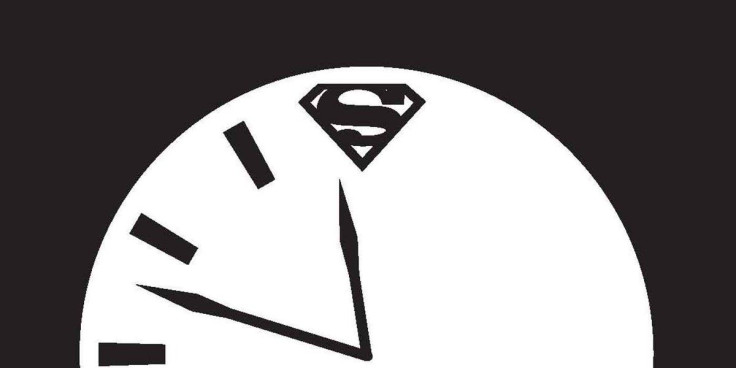Doomsday Clock connects the Watchmen universe to the DC universe. At least that’s the selling point of Geoff Johns and Gary Frank’s sequel story. Batman meets Rorschach, Lex Luthor meets Ozymandias, Superman meets Doctor Manhattan… that's all in the first issue. It was only a matter of time before the two worlds merged together to create the core of Doomsday Clock, but that moment came and went in the first pages of Doomsday Clock #2, leaving fans with a whole lot more than we expected. There’s a crisis in Gotham, but this time it’s an existential one.
This review contains spoilers.
Doomsday Clock #2 is both a beginning and an ending to a story that unravels the characters in the DC Universe as we know it. Aside from the Watchmen and new Doomsday Clock characters introduced in the first issue arriving in Gotham City, #2 raises HUGE questions about the very science behind the DC Universe’s map of characters.
The biggest plot mystery lies beyond the last page of the issue and in the truthfulness of what is dubbed, ‘The Superman Theory,’ detailed in The Bulletin and Daily Planet articles filling the last three pages. It presents more of a thematic issue coupled with Ozymandias and Rorascah’s individual mission. Doomsday Clock takes place a year later than DC’s present continuity, making this world where all heroes are believed to be villains and constructs of the government a tease for the future. What’s to come backtracks from the foundation of hope in which the universe was predicated. Everything we know about metahumans--starting with Metamorpho and Man-Bat--could be an act of deception.
Doomsday Clock #2 calls forth an old Invasion story arc, recently explored in last year’s TV crossover event between The Flash, Arrow, Supergirl and Legends of Tomorrow. Basically, The Dominators invade Earth to learn more about the metagene so they can develop it for themselves. It’s an arms race. Who can become the most powerful? And that’s what’s happening in Doomsday Clock right now. Russia appears to be controlling America’s media narrative behind the scenes (as we saw in the most recent Presidential election). Lex Luthor and Wayne Enterprises compete for the best technology as we learn the American government may be responsible for the majority of the metahuman population, which is much higher in the United States than anywhere else. Coincidence? I have a feeling Geoff Johns doesn’t believe in coincidences… definitely not when Doctor Manhattan is involved.
The latest issue also sees the events that started Watchmen come full circle. The Comedian is back, and he shoots Lex Luthor with a bullet meant for Ozymandias. Watchmen began with an end and Doomsday Clock is doing the same, setting up a future we haven't really gotten to yet. Because of this, this issue deserves a few reads, not necessarily to find more clues about the Superman Theory, but because Johns and Frank have crafted tiny clues within each character’s study.
One such example is the real meaning behind the presence of Marionette and the Mime. Why does Marionette represent a piece of Doctor Manhattan’s humanity? Can the Mime really make his imagination reality? After only a brief introduction, these new characters are let loose in the DC Universe. Wherever each of them ends up first should be a clue about their purpose and place in the story and what will be history when the DC Universe continuity catches up once Doomsday Clock is complete.
The Comedian’s return is the most surprising plot twist so far. Simply making this Comedian the DC Comics version doesn’t seem like Johns’ line of thinking. It’s got to be more complicated, perhaps even more complicated than Doctor Manhattan bringing him back to life. What’s more, how did The Comedian know Ozymandias was at LexCorp? Are he and Lex working together? Why is the new Rorschach so willing to go along with Ozymandias’ plan?
What’s most intriguing about Doomsday Clock isn’t anticipating the twists and turns, it’s a philosophical questions that trickle down to each individual character. Who controls the narrative? The government? The people? The media? Don’t be fooled, these invisible hands are the real antagonists.
At this point, the only person we can name who could have the most direct impact is Doctor Manhattan. Why did we finally learn that the elements radiating off his skin make him blue? Does he have the power to activate the latent metahuman gene, and if so, is he pursuing the idea that if everyone's super, no one is? He may have recognized that his greatest weakness is being all powerful, therefore he’s creating these metas as a safeguard against his own. The very idea of an all-powerful man can skew the world into an arms race and a competition for survival that has led humans to regress back into the very savages we were back when we were hunting our own food.
Who has propelled the Superman Theory into truth is the surface-level question Johns is using to disguise this existential deep-dive into the DC Universe and its origins, but it’s likely we’ll find our answers as we get to know who this new Rorschach is and why Ozymandias is taking part in yet another dubious mission to save the world with Doctor Manhattan. With the guidance of John’s inclusion of DC characters--small, large, and from varying nooks and crannies of the DC history--hopefully all these perspectives will eventually give us a clearer picture of the story this crossover is dying to tell.


















